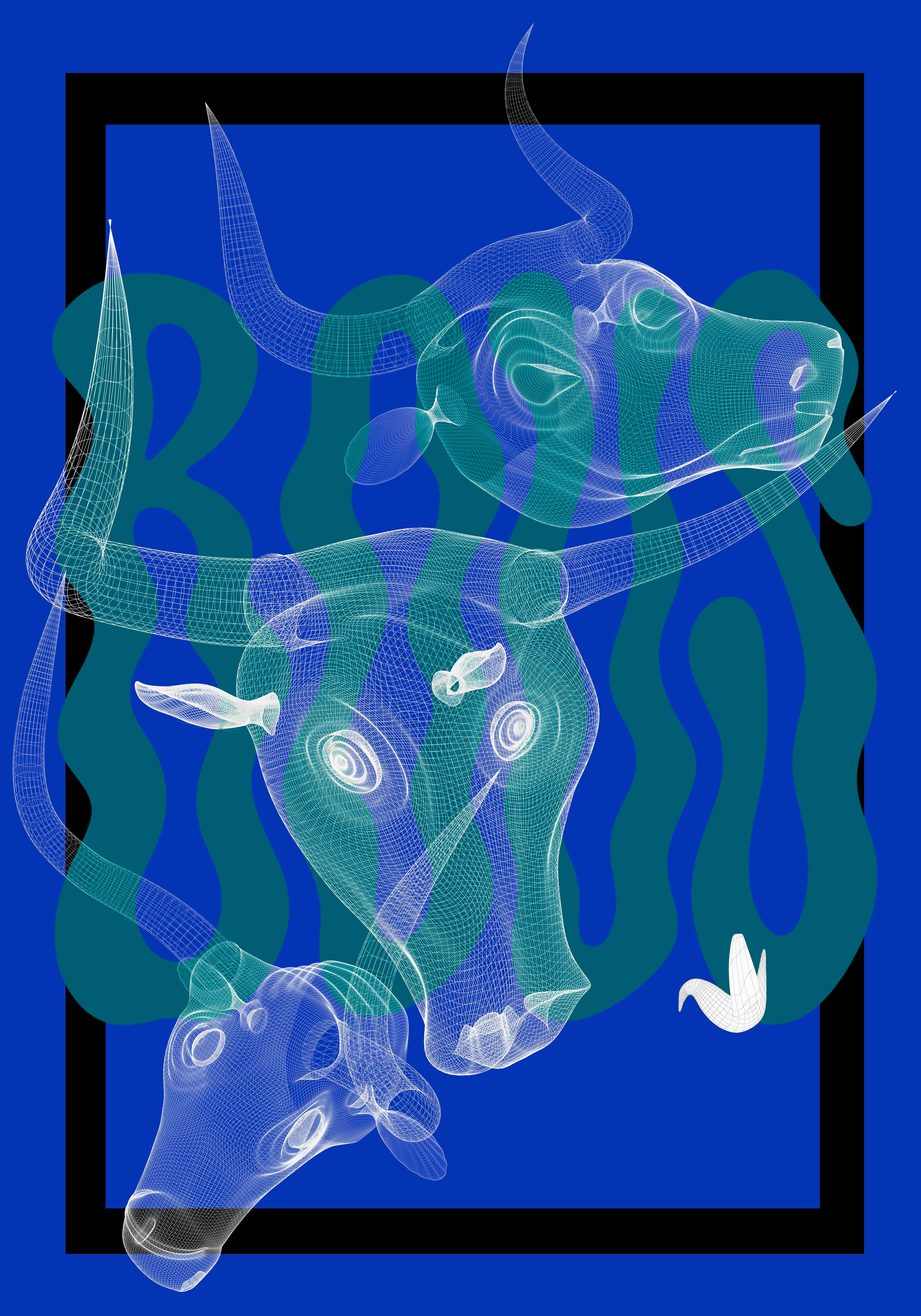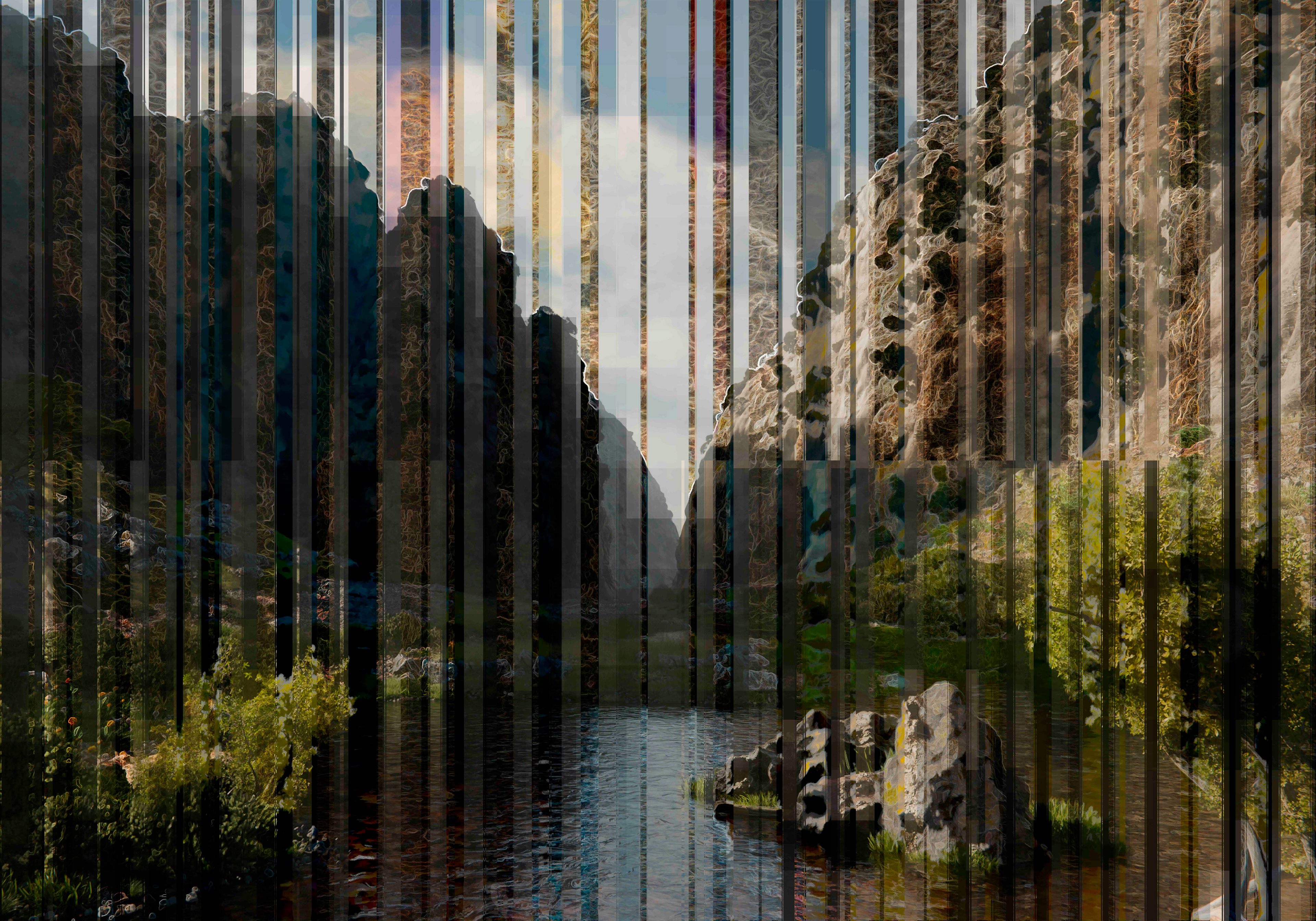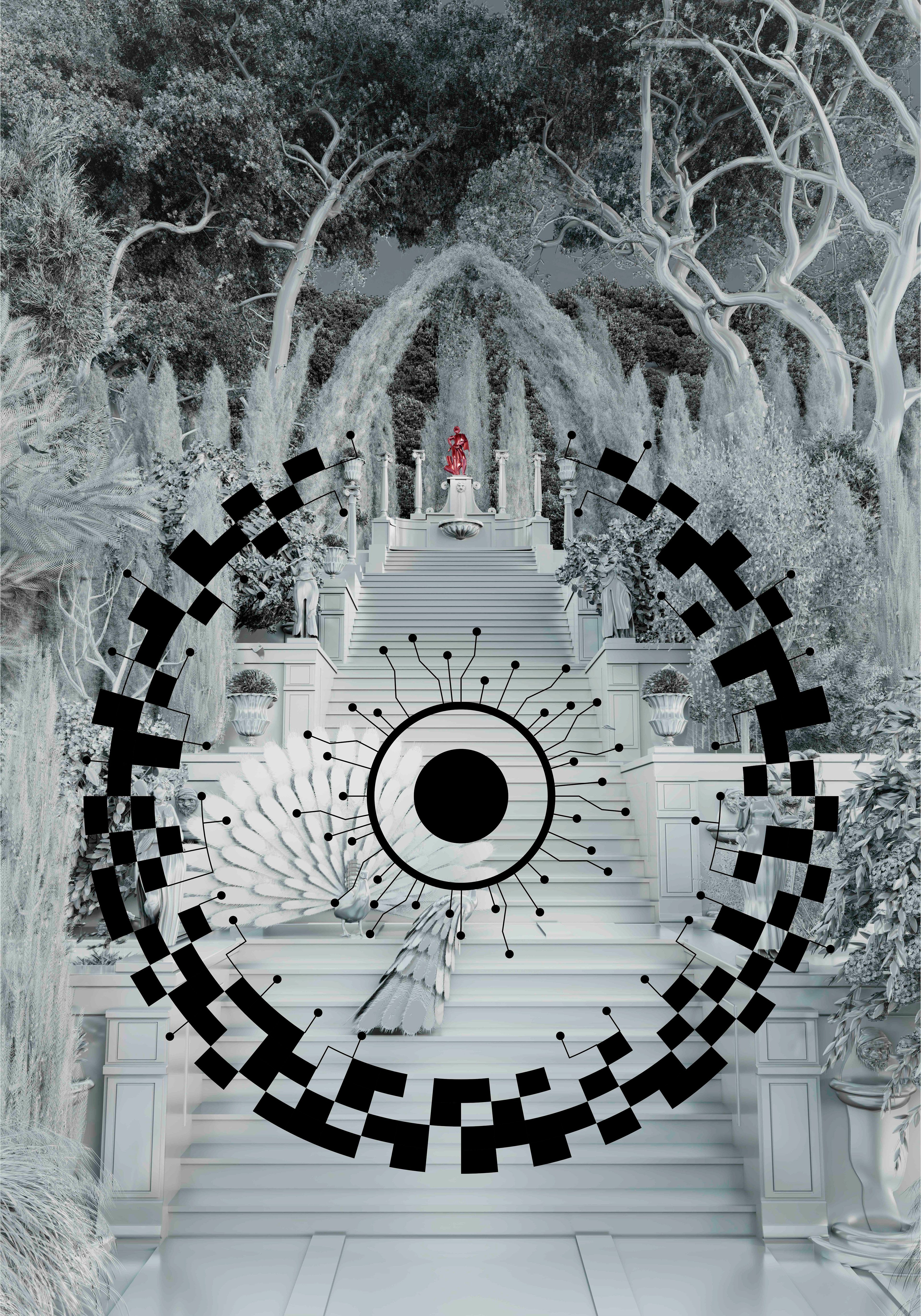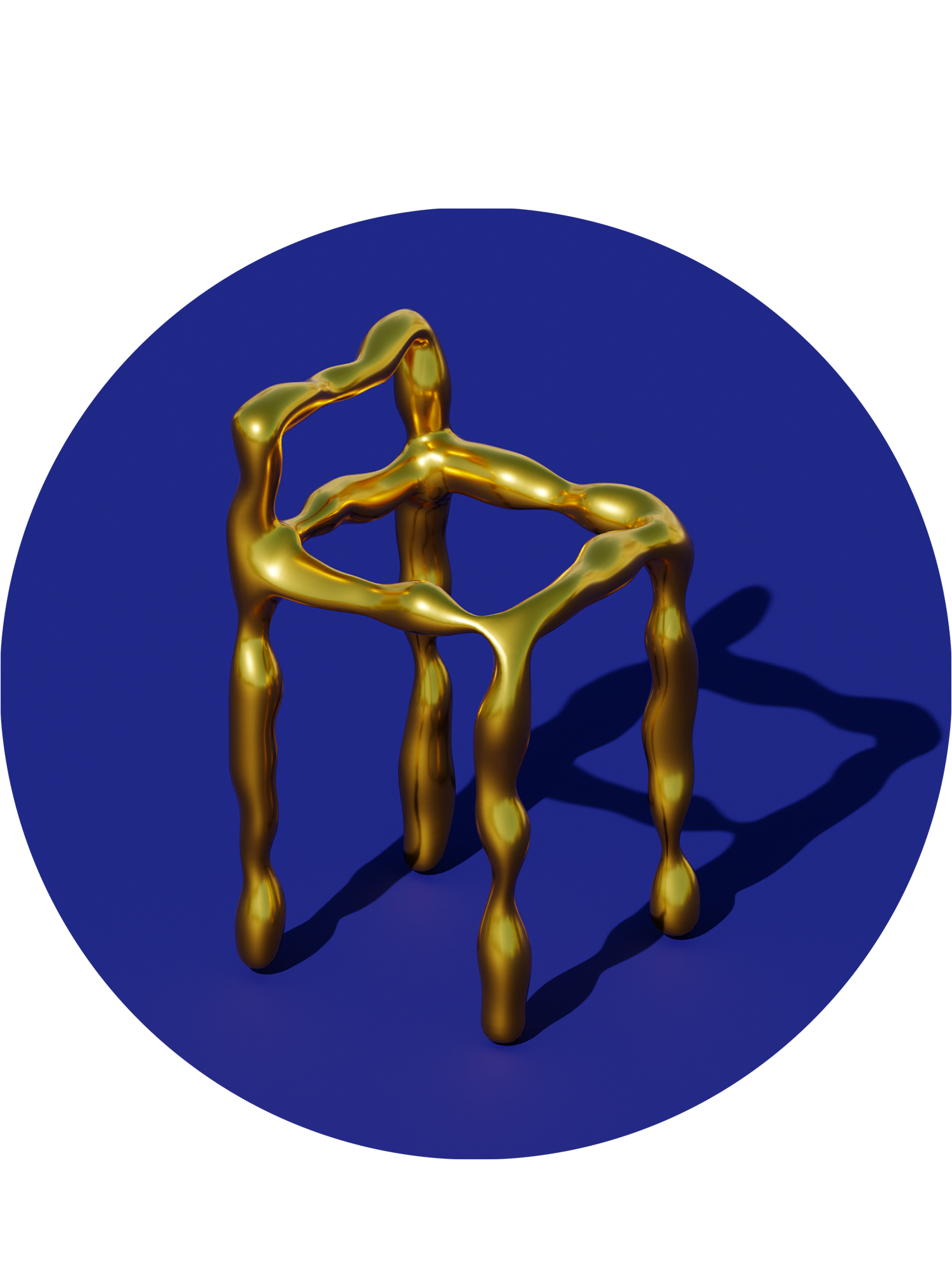CYBERMANIFESTO: TRIPTYCH
Print, VIDEO and Augmented reality installation

3 BOUS

PAREIS

RAIXA
Triptych I, Left: Three Bulls
[633] And others shall sail to the sea-washed Gymnesian rocks – crab-like, clad in skins – where cloakless and unshod they shall drag out their lives, armed with three two-membered slings.3 Their mothers shall teach the far-shooting art to their young offspring by supperless discipline. For none of them shall chew bread with his jaws, until with well-aimed stone he shall have won the cake set as a mark above the board.
“Alexandra” Licofrón of Calcis. Greece, 32a b.C
“Alexandra” Licofrón of Calcis. Greece, 32a b.C
3 BOUS - AR Experience
The Balearic Archipelago, strategically located in the heart of the Mediterranean, has been a crossroads of civilizations since ancient times. This geographical condition has profoundly shaped its cultural identity, its art, and its traditions. While there is no absolute certainty about the first human settlement of the islands, it is believed that the first inhabitants arrived by sea, probably from the East. Understanding the influence of the multiple cultures that have crossed the Balearics is essential for interpreting the current customs. Without this context, there is a risk of perceiving Balearic culture as an isolated entity, when in reality, it is the result of centuries of contact, and fusion between external influences and the locals.
Throughout history, many invaluable pieces have been removed from the Balearic territory, either through sale, plundering, or institutional neglect. Among the most iconic are the Toros de Costitx: three bronze sculptures representing bull heads, found in 1894 in Son Corró, Costitx. This discovery marked a turning point in Balearic archaeology, both because of the extraordinary artistic quality of the pieces and the enigmatic ritualistic context in which they were found. Dated around the 5th century BC, these figures belong to the final period of the Talayotic culture and are one of the finest surviving examples of metal sculpture from the islands.
The bulls were found in what is presumed to have been an open-air sanctuary, a sacred space probably associated with fertility cults, the protection of livestock, or zoomorphic deities linked to strength and regeneration. The bull, a recurring symbol in Mediterranean cultures such as those of the Minoan or Punic, appears reinterpreted with a uniquely plastic look, revealing the aesthetic sophistication of a society that was long considered marginal or primitive.
However, after their discovery, the sculptures were sold for a paltry sum: only three pesetas (approximately 0,8€) per kilogram of bronze. An act that stripped the object not only of its economic value but also of its symbolic, spiritual, and cultural weight. The pieces ended up in the hands of a private collector and did not enter the National Archaeological Museum until much later. This episode raises qqurgent questions about heritage management in peripheral contexts: how many other ritual objects have disappeared without a trace? How much material memory has been disregarded or discarded for not fitting the standards of the culture in power?
Today, the Toros de Costitx are much more than archaeological artifacts: they are remnants of an ancestral spirituality, of a symbiotic relationship between ancient peoples and their environment. At the same time, they are a prime example of the history of plundering, forgetfulness, and the struggle for cultural dignity. Their expressive power, their enigmatic aura, and their connection to the Balearic landscape make them one of the most powerful works of protohistoric art in the western Mediterranean.
Throughout history, many invaluable pieces have been removed from the Balearic territory, either through sale, plundering, or institutional neglect. Among the most iconic are the Toros de Costitx: three bronze sculptures representing bull heads, found in 1894 in Son Corró, Costitx. This discovery marked a turning point in Balearic archaeology, both because of the extraordinary artistic quality of the pieces and the enigmatic ritualistic context in which they were found. Dated around the 5th century BC, these figures belong to the final period of the Talayotic culture and are one of the finest surviving examples of metal sculpture from the islands.
The bulls were found in what is presumed to have been an open-air sanctuary, a sacred space probably associated with fertility cults, the protection of livestock, or zoomorphic deities linked to strength and regeneration. The bull, a recurring symbol in Mediterranean cultures such as those of the Minoan or Punic, appears reinterpreted with a uniquely plastic look, revealing the aesthetic sophistication of a society that was long considered marginal or primitive.
However, after their discovery, the sculptures were sold for a paltry sum: only three pesetas (approximately 0,8€) per kilogram of bronze. An act that stripped the object not only of its economic value but also of its symbolic, spiritual, and cultural weight. The pieces ended up in the hands of a private collector and did not enter the National Archaeological Museum until much later. This episode raises qqurgent questions about heritage management in peripheral contexts: how many other ritual objects have disappeared without a trace? How much material memory has been disregarded or discarded for not fitting the standards of the culture in power?
Today, the Toros de Costitx are much more than archaeological artifacts: they are remnants of an ancestral spirituality, of a symbiotic relationship between ancient peoples and their environment. At the same time, they are a prime example of the history of plundering, forgetfulness, and the struggle for cultural dignity. Their expressive power, their enigmatic aura, and their connection to the Balearic landscape make them one of the most powerful works of protohistoric art in the western Mediterranean.
Triptych III, Center: Pareis
Mass tourism, driven by profit, has displaced communities from their own homes and turned our the Mallorcan coast into a theatre of consumption. The landscapes that once held our collective memory have been transformed into ephemeral, artificial backdrops, serving demands that have little to do with the land. The Torrent de Pareis, one of the most iconic natural wonders of Mallorca, embodies this tension. What was once a symbol of wild, untamed, and ancestral beauty is now reduced to a wallpaper, a digital souvenir, in the economy of likes.
Located on the rugged northwest coast of the island, the Torrent de Pareis is a geological monument sculpted by millennia of erosion. This limestone canyon runs through the Serra de Tramuntana from Escorca to merge with the sea at the beach of Sa Calobra, unveiling an awe-inspiring landscape of vertical cliffs that rise more than 200 meters in height. Its name, "pareis" — which in Mallorcan refers to "pares" or "twins" — alludes to the two gorges that converge at its final stretch: the Torrent de Lluc and the Torrent des Gorg Blau.
Since it was "discovered" for tourism in the early 20th century, the river has become a symbolic and literal border between vastly different Mallorcas: the interior and the coastal, the local and the tourist, the timeless and the transient. It is a liminal place, a threshold between worlds, where the natural and the cultural intertwine ambiguously. Its growing media exposure and overexploitation as a tourist destination raise an urgent question: how do we preserve these landscapes that make up the soul of a territory without betraying their essence, without turning them into an empty postcard, a backdrop without history?
Immovable, ancient, telluric: the Torrent de Pareis endures as an open wound in time, as a reminder of what remains when everything changes. Against the vertigo of globalization, standardization, and consumption, the river stands firm, indifferent to the noise, asserting its presence with the same force as ever. In contemplating it, we have a sense of how small and fleeting our lives are. And become conscious of a deep longing to reconnect with the essential, the sacred, and that which cannot be possessed.
Located on the rugged northwest coast of the island, the Torrent de Pareis is a geological monument sculpted by millennia of erosion. This limestone canyon runs through the Serra de Tramuntana from Escorca to merge with the sea at the beach of Sa Calobra, unveiling an awe-inspiring landscape of vertical cliffs that rise more than 200 meters in height. Its name, "pareis" — which in Mallorcan refers to "pares" or "twins" — alludes to the two gorges that converge at its final stretch: the Torrent de Lluc and the Torrent des Gorg Blau.
Since it was "discovered" for tourism in the early 20th century, the river has become a symbolic and literal border between vastly different Mallorcas: the interior and the coastal, the local and the tourist, the timeless and the transient. It is a liminal place, a threshold between worlds, where the natural and the cultural intertwine ambiguously. Its growing media exposure and overexploitation as a tourist destination raise an urgent question: how do we preserve these landscapes that make up the soul of a territory without betraying their essence, without turning them into an empty postcard, a backdrop without history?
Immovable, ancient, telluric: the Torrent de Pareis endures as an open wound in time, as a reminder of what remains when everything changes. Against the vertigo of globalization, standardization, and consumption, the river stands firm, indifferent to the noise, asserting its presence with the same force as ever. In contemplating it, we have a sense of how small and fleeting our lives are. And become conscious of a deep longing to reconnect with the essential, the sacred, and that which cannot be possessed.
Triptych II, Right: Raixa
The Raixa estate, located at the foot of the Serra de Tramuntana, is one of Mallorca’s most unique cultural gems. Although its origins date back to the Islamic era, it was under the vision of Cardinal Antoni Despuig in the 18th century, that it acquired its current neoclassical and romantic character. Among the ensemble, one of the most emblematic and meaningful spaces is the staircase garden — also known as the garden of Apollo — a landscape work where architecture, nature, water, and mythology converge in a choreography of enlightened sensitivity.
This garden is structured around a monumental staircase that ascends from a lower terrace to a classicist temple crowned by the figure of the god Apollo, symbol of reason, beauty, and harmony. On either side of the path, cypress trees, fountains, and stone walls frame a journey that is not only physical but also symbolic: a spiritual and intellectual elevation, a transition from the earthly world to the classical ideal. This setting is part of the Grand Tour tradition, where gardens like those of Villa d'Este or Villa Medici were not mere backdrops but stages for aesthetic contemplation and philosophical reflection.
The garden of Apollo in Raixa thus becomes a space where nature is subject to the laws of art, and the Mallorcan landscape dialogues with the archetypes of Greco-Roman culture. By combining indigenous elements — water, stone, Mediterranean vegetation — with geoemtric forms and mythological references, the garden acts as a theater for the enlightened soul: a place where the longing for balance, knowledge, and transcendence is represented through the harmony between humanity and the world.
In the island context, Raixa is a rare exception: a place where European humanism is embodied in the island landscape. Reminiscent of what the estate once aspired to be, visiting the staircase garden today is not only an aesthetic experience but a symbolic journey that invites us to rethink how cultures have used art and nature to imagine other ways of living, feeling, and inhabiting the world.
This garden is structured around a monumental staircase that ascends from a lower terrace to a classicist temple crowned by the figure of the god Apollo, symbol of reason, beauty, and harmony. On either side of the path, cypress trees, fountains, and stone walls frame a journey that is not only physical but also symbolic: a spiritual and intellectual elevation, a transition from the earthly world to the classical ideal. This setting is part of the Grand Tour tradition, where gardens like those of Villa d'Este or Villa Medici were not mere backdrops but stages for aesthetic contemplation and philosophical reflection.
The garden of Apollo in Raixa thus becomes a space where nature is subject to the laws of art, and the Mallorcan landscape dialogues with the archetypes of Greco-Roman culture. By combining indigenous elements — water, stone, Mediterranean vegetation — with geoemtric forms and mythological references, the garden acts as a theater for the enlightened soul: a place where the longing for balance, knowledge, and transcendence is represented through the harmony between humanity and the world.
In the island context, Raixa is a rare exception: a place where European humanism is embodied in the island landscape. Reminiscent of what the estate once aspired to be, visiting the staircase garden today is not only an aesthetic experience but a symbolic journey that invites us to rethink how cultures have used art and nature to imagine other ways of living, feeling, and inhabiting the world.
